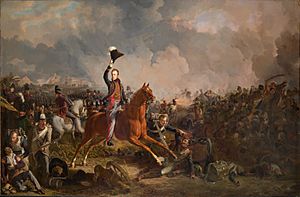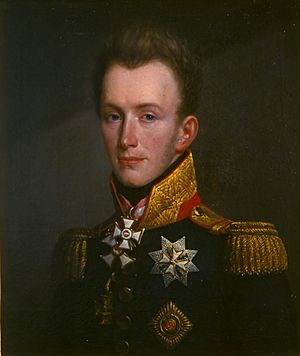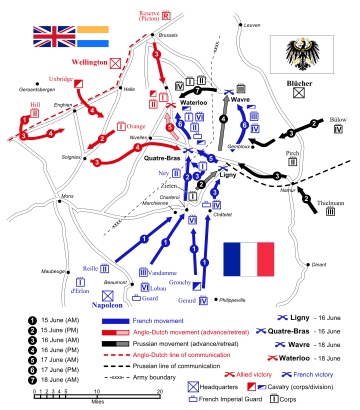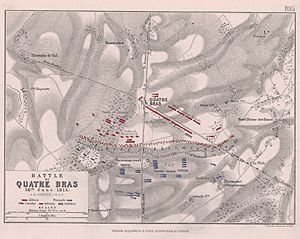Battle of Quatre Bras facts for kids
Quick facts for kids Battle of Quatre Bras |
|||||||
|---|---|---|---|---|---|---|---|
| Part of the Waterloo campaign | |||||||
 The Prince of Orange at the Battle of Quatre-Bras, by Jan Willem Pieneman |
|||||||
|
|||||||
| Belligerents | |||||||
|
|||||||
| Commanders and leaders | |||||||
|
|||||||
| Strength | |||||||
| 20,000–21,000 | 32,000–36,000 | ||||||
| Casualties and losses | |||||||
| 4,140–4,400 killed or wounded | 4,800–5,600 killed or wounded | ||||||
The Battle of Quatre Bras was a big fight that happened on June 16, 1815. It was an important warm-up battle, just two days before the famous Battle of Waterloo. The battle took place near a crucial crossroads called Quatre Bras in what is now Belgium.
The fight was between parts of the army led by the Duke of Wellington (who commanded British and allied troops) and the French army. The French forces were led by Marshal Michel Ney, under Napoleon Bonaparte. Wellington's army held the field at the end of the day. This was a tactical victory for him. However, the French stopped Wellington from helping the Prussian army. The Prussians were fighting Napoleon at Ligny at the same time. This made it a strategic victory for the French.
Contents
Why Quatre Bras Was Important
Napoleon faced two large armies: Wellington's from the west and the Prussians under Field Marshal von Blücher from the east. His plan was to defeat each army one by one before they could join forces. He wanted to cross into Belgium without anyone knowing. Then, he would drive a wedge between the two enemy armies.
Napoleon planned to beat the Prussian army first, forcing them to retreat east. After that, he would turn to fight Wellington, pushing his army back towards the coast. He knew that if Wellington's army and the Prussians combined, they would be stronger than his French army.
The crossroads at Quatre Bras was a very important spot. If the French controlled it, they could stop Wellington's troops from moving south-east. This would prevent Wellington from joining the Prussians, whom Napoleon planned to attack at Ligny on June 16.
Getting Ready for Battle
Even though the allied commanders were getting some information, Napoleon's plan worked well at first. Wellington himself said that Napoleon had tricked him, gaining a 24-hour head start.
Wellington's main job was to protect Brussels from the French. But he wasn't sure which way Napoleon's army would come. He even got some false reports about a French move through Mons to the southwest.
Wellington first heard about fighting around 3:00 PM on June 15. This news came from the Prince of Orange, one of the allied commanders. Over the next few hours, he learned that the French had fought with Prussian troops near Charleroi that morning.
This news made Wellington order his army to gather at 6:00 PM. But he still wasn't sure exactly where to send them. It wasn't until almost midnight, when he found out the area near Mons was clear, that he ordered his army to move towards the Prussians.

This nine-hour delay meant Wellington couldn't get enough troops to help von Blücher at the Battle of Ligny on June 16. Wellington didn't even send his whole army to Quatre Bras that day. He still worried about a French move through Mons.
However, the headquarters of the allied First Corps, led by the Prince of Orange, decided to ignore Wellington's order. Instead of gathering at Nivelles, they took the initiative and moved towards Quatre Bras.
Napoleon's Plan for June 16
Napoleon's plan for June 16 assumed that the allied forces, caught by surprise, wouldn't try to gather their troops too far forward. He wanted to send an advanced group to Gembloux to find and push back von Blücher's Prussians.
To help with this, his reserve troops would first move to Fleurus. There, they would support Marshal Grouchy, who was supposed to drive back the Prussians. Once the French held Sombreffe, Napoleon planned to move his reserve west. They would join Marshal Ney, who was supposed to have already taken the Quatre Bras crossroads.
Marshal Ney was ordered to gather his troops at Quatre Bras. He was to send an advanced group 10 kilometers (6 miles) north. He also needed to send a connecting division to Marbais to link up with Grouchy. Then, the French center and left wing would march towards Brussels at night. This would split the allied forces, making it easier to defeat them one by one.
On June 15, as the Prussian I Corps pulled back towards Ligny, there was a risk. Ney might have advanced through Quatre Bras without much resistance. Major-General Jean Victor de Constant Rebecque, chief of staff to the Prince of Orange, saw this danger. He ordered Lieutenant-General Hendrik George de Perponcher Sedlnitsky to send his 2nd Brigade to take Quatre Bras.
This brigade, made up of two regiments from Nassau, arrived around 2:00 PM on June 15. Prince Bernhard was able to set up his troops before the first French scouts arrived. These French lancers were stopped at Frasnes. The Nassau troops then pulled back to the Bois de Bossu, a thick forest near Quatre Bras.
Ney asked for infantry support, but it was getting dark. His infantry was spread out along the road. So, Ney decided to camp for the night and attack Quatre Bras with more force the next day. Early on the evening of June 15, Rebecque ordered more troops to reinforce Prince Bernhard's brigade. He did this even though Wellington had ordered the I Corps to gather at Nivelles.
By ignoring Wellington's direct order and acting on his own, Rebecque made sure the Battle of Quatre Bras happened the next day. This stopped the French from keeping the two allied armies apart and defeating them one by one.
Ney spent the morning of June 16 gathering his troops and checking on the enemy at Quatre Bras. He was told the enemy had been reinforced. But he didn't make any serious moves to capture the crossroads until noon. He could have taken it easily earlier. Meanwhile, Grouchy reported from Fleurus that Prussians were coming from Namur. But Napoleon didn't seem to think this was very important.
Napoleon was still at Charleroi when, between 9:00 AM and 10:00 AM, he heard that enemy forces had gathered at Quatre Bras. He immediately wrote to Ney, saying these must be some of Wellington's troops. He told Ney to gather his forces and crush the enemy in front of him. Napoleon then went to Fleurus, arriving around 11:00 AM.
Meeting at the Windmill
Shortly after 11:00 AM, Wellington saw that the French didn't have many troops at Frasnes, south of Quatre Bras. At the same time, he heard that the Prussians at Ligny were being threatened by a large French force.
Wellington rode to meet with von Blücher at the Windmill of Bussy, between Ligny and Brye. This windmill was the highest point of the Prussian position. From there, the leaders could see the French setting up their attack.
Wellington realized that Napoleon was bringing his main army against the Prussians. He offered to help von Blücher by attacking the French from their left and rear. This would create a strong distraction to help the Prussians, whose right side was the weakest.
After thinking about how long it would take to gather his troops, Wellington decided it would be better to support the Prussian right flank directly if possible. This support depended on the situation and Wellington's judgment. Wellington said he was confident he could help and gather enough troops to attack soon. Then, he rode back to Quatre Bras.
Who Fought at Quatre Bras
At the start of the battle, Marshal Michel Ney led the French forces, with about 18,000 men. This included 2,000 cavalry and 32 cannons. They faced about 8,000 infantry and 16 cannons, led by William, Prince of Orange.
The Dutch and Nassau troops were spread out thinly south of the Quatre Bras crossroads. Fresh allied troops began to arrive two hours later, along with Wellington, who took command. As the day went on, more Dutch, British, and Brunswick troops arrived faster than French reinforcements. The French eventually had about 24,000 men.
The Battle Begins
Fighting started late in the afternoon on June 15. A small Polish cavalry unit tried to attack the allied forces. But the Dutch and Nassau commanders were ready. The lancers were met with cannon and musket fire, losing men and horses before retreating. Patrols were sent out, and positions were held until the next morning.
From 5:00 AM on June 16, there were constant small fights between the allied and French forces. Neither side gained a clear advantage. Some Prussian cavalry fought with French lancers, but the lancers were pushed back by allied cannons. Two companies of Nassau infantry advanced but were pushed back by the French. The small fights stopped after 6:00 AM when the Prince of Orange arrived.
The main battle began around 2:00 PM. Ney gathered 22 cannons and started firing at the allied positions. French soldiers in columns attacked, with many skirmishers (light infantry) in front. The Dutch troops fired their muskets, but they were outnumbered. Those east of the main road were quickly pushed back.
The Nassau troops retreated to Grand-Pierrepont farm, and Dutch troops went to Gemioncourt. But the allies managed to hold the nearby wood. Facing three French infantry divisions and a cavalry brigade, the situation became very difficult for the allied 2nd Division.
Around 3:00 PM, the British 5th Infantry Division and the Dutch 3rd Light Cavalry Brigade arrived. The Duke of Wellington returned from his meeting with Blücher and took command. He placed the British division on the allied left side, stopping the French advance east of the road.
The fresh French 6th Division arrived. A fierce fight broke out along the entire line. The British division held its ground. The French 6th Division attacked Grand-Pierrepont. The Nassau troops were forced to leave the farm and were pushed into the Bossu wood. They fought from tree to tree, slowing the French. At Gemioncourt, the Dutch troops caused problems for the French.
The battalion defending Gemioncourt Farm lost 62% of its men that day. It was pushed out by French regiments. But when they saw British troops coming, the Dutch regrouped. The British regiment thought the farmhouse was lost and retreated. The Dutch, thinking they would get help, charged the farmhouse again. They drove the French from around the farm but couldn't take the farm itself. The Dutch managed to take a position south of the farm, where their Prince joined them. With cannon support, they pushed back French cavalry. The Dutch lost and retook the farm again, but eventually lost it for good.
By 3:00 PM, the French had formed a line from Pierrepont through Gemioncourt to Piraumont. At 3:30 PM, the Dutch 2nd Light Cavalry Brigade, led by the Prince of Orange, charged the French line. They were met by French cavalry and pushed back. But this gave the tired Dutch infantry time to regroup. When the Dutch cavalry pulled back, Scottish infantry accidentally shot at them. Their uniforms looked like the French cavalry uniforms.
The Brunswick Corps arrived, led by the Duke of Brunswick. But their commander was fatally wounded while leading a charge, and the attack failed. At 4:15 PM, Ney received Napoleon's order to attack strongly. He ordered his II Corps to attack with more force.
On Ney's left, Prince Jérôme pushed the allies out of the Bossu Wood. French forces advanced almost to the crossroads. British regiments held their ground against the French infantry. French cavalry attacked and badly hurt two British regiments before being driven off.

At 5:00 PM, the British 3rd Division arrived from Nivelles. This arrival shifted the numbers back in favor of the allies. Fifteen minutes later, Ney heard that the French I Corps had moved east to help at the Battle of Ligny. This happened without his direct order or knowledge.
At 5:30 PM, he received an unclear order from Napoleon. It told him to take Quatre Bras and then turn east to crush Blücher at Ligny. With the allied reinforcements arriving, Ney knew he could only take Quatre Bras with the I Corps. He immediately sent urgent orders for the I Corps to return. To keep pressure on Wellington, Ney ordered Kellermann to lead his cavalry and break through Wellington's line.
Kellermann's cavalry caught a British brigade in a line formation. One regiment was badly hurt, losing its flag. Two other regiments were saved by running into the Bossu Wood, where they quickly regrouped. The French cavalry reached the crossroads but were pushed back by close-range cannon and musket fire.
The arrival of the British 1st Infantry Division gave Wellington enough strength to counter-attack. Prince Jérôme was forced to retreat and give up the Bossu wood to the British Guards. When the Guards and other allied units came out of the wood, they faced heavy fire from French infantry and a cavalry attack. The Guards were caught in a line and forced to flee back into the wood. This cavalry attack caused many casualties among the British Guards. There were a few more small fights, but the battle was over. By 9:00 PM, when the fighting stopped, the French had lost all the ground they had gained.
What Happened Next
The battle cost Ney about 4,000 men, while Wellington lost about 4,800. Even though the allies won the field, the French stopped them from helping the Prussians at the Battle of Ligny. Wellington's army, after learning the Prussians were defeated, had to retreat north along the Brussels road. This moved them further away from the Prussians, who retreated north-east towards Wavre.
There has been much discussion about what would have happened if the French I Corps had fought at either Ligny or Quatre Bras. Since it didn't, Napoleon chose to follow Wellington with most of his forces. Two days later, they met at Waterloo.
The allied victory at Quatre Bras did stop Ney from controlling these important crossroads. This slowed down the French advance. It allowed Wellington to take a strong position on the Waterloo battlefield. Without this, some believe, the allies might have lost.
After the Waterloo campaign, the Dutch King William I gave Wellington the title Prince of Waterloo. Along with the title came land, which included a large part of the Quatre Bras battlefield. As the landowner, Wellington and his family later cut down much of the Bossu wood for timber.
Images for kids
More to Explore
- Order of battle of the Battle of Quatre Bras
- List of Napoleonic battles













